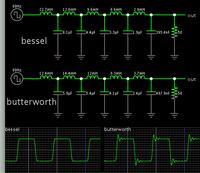matrixofdynamism
Advanced Member level 2
I understand the concept of low pass high pass band pass and band stop filters. However, later books talk of active filters and in that they talk of Butterworth, Chebyshev I & II, Elliptic and Bessel filters and explain the tradeoffs in pass band ripple vs stop band ripple and the roll off rate. What they never explain is how were Butterworth, Chebyshev I & II, Elliptic and Bessel filters arrived at in the first place. How were they invented? And why do books only mention these types?
